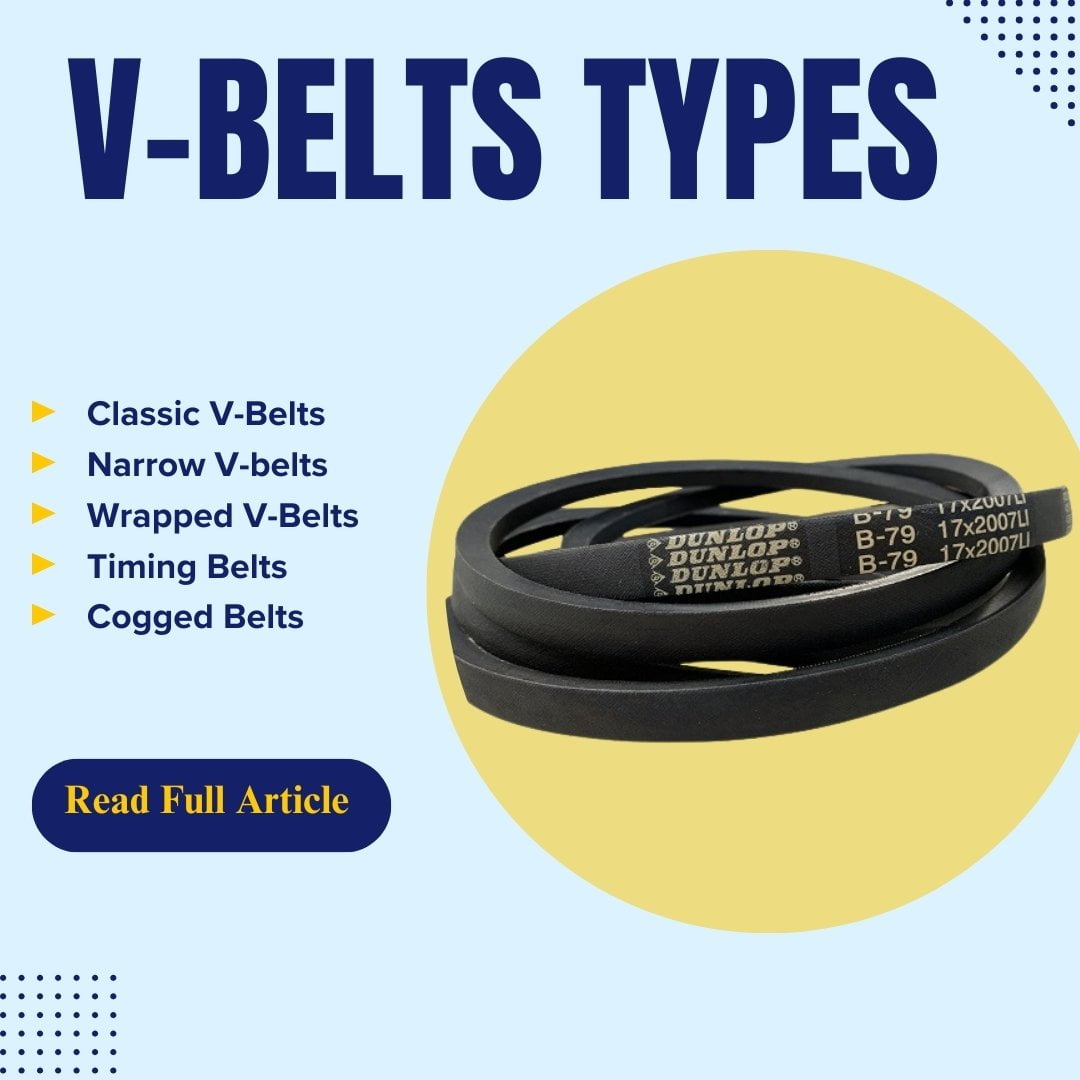August 24, 2024 By Bilal 6 minutes read

V-Belts are an essential component in many mechanical systems, playing a critical role in power transmission across various industries. They are designed to efficiently transfer energy from one pulley to another, making them vital in machinery ranging from small appliances to large industrial equipment.
In this article, we will explore the different types of V-Belts, their applications, and provide a comprehensive V-Belt code guide. Understanding how to read V-Belt numbers and their classifications will empower you to make informed decisions when selecting the right belt for your needs.
Definition:
V-Belts are flexible loops made of rubber or fabric that are used to connect rotating shafts in machines. They are characterized by their trapezoidal cross-section, which allows them to fit snugly into pulley grooves, providing a secure grip and preventing slippage. The design of V-belts enables them to handle high torque loads while maintaining efficiency.

They are primarily used in power transmission systems to transfer rotational energy from the engine or motor to various components, such as fans, pumps, and conveyor belts. Their ability to absorb shocks and vibrations makes them ideal for many applications, ensuring smooth and reliable operation.
V-Belts come in various types, each designed for specific applications and environments. Understanding the differences between these types is crucial for selecting the right one for your machinery. Below are the most common types of V-Belts:
Classical V-Belts, also known as standard V-Belts, are the most widely used type in mechanical applications. They are available in various sizes and cross-sectional shapes, including A, B, C, and D profiles. These belts are suitable for light to moderate industrial applications and are known for their durability and reliability.
Applications of Classical V-Belts:

Narrow V-Belts are designed to provide a higher power transmission capacity in a smaller space. They have a narrower cross-section compared to classical V-Belts, allowing for tighter pulley arrangements and reduced weight.
Applications of Narrow V-Belts:

Wrapped V-Belts are reinforced with a protective cover that enhances their durability and resistance to wear. The outer layer helps to protect the belt from environmental factors such as oil, heat, and moisture.
Applications of Wrapped V-Belts:

Cogged V-Belts feature notches on the inner surface, allowing for increased flexibility and better grip on the pulleys. This design helps reduce bending resistance, improving efficiency and performance.
Applications of Cogged V-Belts:
Timing belts, though not traditional V-Belts, play a similar role in power transmission. They have teeth that fit into corresponding grooves on pulleys, ensuring precise timing between the components they connect.
Applications of Timing Belts:

Variable speed V-belts are designed to operate effectively over a range of speeds. They are often used in applications where the speed of the driven equipment can change.
Understanding V-Belt codes is essential for selecting the right belt for your application. Each V-Belt has a unique code that provides information about its size, profile, and characteristics. This section will elaborate on how to read V-Belt numbers, ensuring you can identify the correct belt for your machinery.
V-Belt codes typically consist of letters and numbers that specify the belt’s type and dimensions. Here’s a detailed breakdown of a typical V-Belt code:
The first part of the V-Belt code is a letter or a combination of letters that indicates the profile type of the belt. Common profile types include:

The letter designation is crucial because it helps you understand the belt’s compatibility with your pulleys and the load it can handle.
Following the letter designation, the number represents the length of the belt in inches. For example, in the code A36, the “36” indicates that the belt has an inner circumference of 36 inches. This length is critical for ensuring that the belt fits properly within the pulley system.

Example of V-Belt Codes:
To illustrate how to read V-Belt codes, consider the following examples:
If you need to replace a V-Belt but the code is worn off or unreadable, you can measure the belt to determine its size. Here’s how to do it:
V-Belts are widely used across various industrial sectors, each with unique requirements and challenges. Below are some key industries where V-Belts play a crucial role:
In manufacturing, V-Belts are essential for driving machinery, conveyor systems, and assembly lines. Their ability to handle heavy loads and provide reliable performance makes them indispensable.
Agricultural machinery relies on V-Belts for powering equipment such as tractors, combines, and irrigation systems. Their durability and efficiency are vital for the demanding conditions of agricultural operations.
In the automotive industry, V-Belts are used to drive various engine components, including alternators, power steering pumps, and air conditioning compressors. Their performance directly impacts vehicle efficiency and reliability.
Heating, ventilation, and air conditioning (HVAC) systems utilize V-Belts to drive fans and blowers. Proper selection of V-Belts is crucial for maintaining energy efficiency and indoor air quality.
In mining and construction, heavy machinery relies on V-Belts to power equipment such as crushers, conveyors, and excavators. The ability to withstand harsh conditions makes V-Belts a preferred choice in these industries.
In summary, V-belts are a vital component in many industries, providing efficient power transmission for a variety of applications. Understanding the different types of V-belts, how to read their numbers, and their specific applications can help you make informed decisions when selecting the right belt for your machinery.
By following the V-belt code guide and considering factors such as tension, alignment, and environment, you can ensure that your V-belt performs optimally.Whether you’re involved in manufacturing, automotive, agriculture, or HVAC systems, knowledge of V-belts is essential for maintaining efficiency and performance in your operations.
Remember to regularly inspect and maintain your V-belts to extend their lifespan and improve the reliability of your machinery. With this comprehensive understanding of V-belts and their applications, you are now better equipped to choose the right solutions for your needs.
A V-belt is a type of power transmission belt that has a trapezoidal cross-section, allowing it to fit snugly into the grooves of pulleys. It is commonly used in various machinery and vehicles to transfer power from one component to another
The two main types of V-belts are classic V-belts and wedge V-belts. Classic V-belts are designed for lower horsepower applications, while wedge V-belts have a narrower and deeper profile, allowing for higher power capacity
Measuring a V-belt can be tricky. The most accurate method is to measure the inner circumference of the belt. If the label is worn off, you can measure the outer circumference and then calculate the inner circumference
Common causes of V-belt failure include misalignment of pulleys, which can lead to twisting and premature wear, and worn or damaged pulleys that affect the belt’s sidewalls.
Belt slippage is often caused by flexing brackets under load. Ensuring proper tension and alignment of the pulleys is crucial, and checking for any flexing in the brackets can help resolve the issue
Wrapped V-belts have a rubberized fabric covering, while raw edge V-belts have exposed rubber sidewalls and molded cogs on the bottom, which can provide better grip and flexibility.
To select the correct V-belt, you need to consider the top width, depth, and length of the belt required for your specific application. Using a V-belt size chart can be helpful
Regular maintenance includes checking the tension of the belt, ensuring proper alignment of pulleys, and inspecting for any signs of wear or damage
Regular maintenance includes checking the tension of the belt, ensuring proper alignment of pulleys, and inspecting for any signs of wear or damage
Key challenges include environmental concerns, high initial costs, displacement of communities, and the need for suitable geographic locations.
The lifespan of a V-belt can vary widely depending on usage, maintenance, and environmental conditions. Regular inspections and proper maintenance can extend its life significantly
To install a V-belt, place it over the pulleys, ensuring it fits tightly into the grooves. Adjust the tension using a tensioner or idler pulley as needed
The included angle of a V-belt is typically between 30 to 40 degrees, which helps in maintaining grip and reducing wear

Amber Raza, who earned her PhD in Electrical Engineering from the University of California, Berkeley, is an expert in wireless communication systems. Her innovative research in 5G technology is paving the way for next-generation connectivity.
Explore the Engineer’s Guidebook! Find the latest engineering tips, industry insights, and creative projects. Get inspired and fuel your passion for engineering.
© 2023-2024 Engineer’s Guidebook. All rights reserved. Explore, Innovate, Engineer.
6 Responses
Undeniably believe that which you said. Your favorite
justification appeared to be on the web the easiest thing to be aware of.
I say to you, I certainly get annoyed while people consider worries that they just don’t know about.
You managed to hit the nail upon the top and also defined out the whole thing without having side-effects , people
can take a signal. Will likely be back to get more. Thanks
This article provides a fantastic breakdown of the “Types of V-Belts and Their Applications”! It’s incredibly practical and easy to understand, making it a valuable resource for selecting the right V-belt for any engineering application.
The clear explanations of each type and their suitable uses are particularly helpful. Highly recommend this for anyone working with power transmission systems!
Excellent article on v-belts. your knowledge is good
Can I simply say what a relief to discover an individual who genuinely understands
what they are talking about on the internet. You definitely understand how
to bring a problem to light and make it important. More and
more people should check this out and understand this article. It’s surprising you aren’t more popular since
you surely have the gift.
where do you get this information i think your information is incorrect kindly check this also
I like this weblog so much, bookmarked. “Respect for the fragility and importance of an individual life is still the mark of an educated man.” by Norman Cousins.